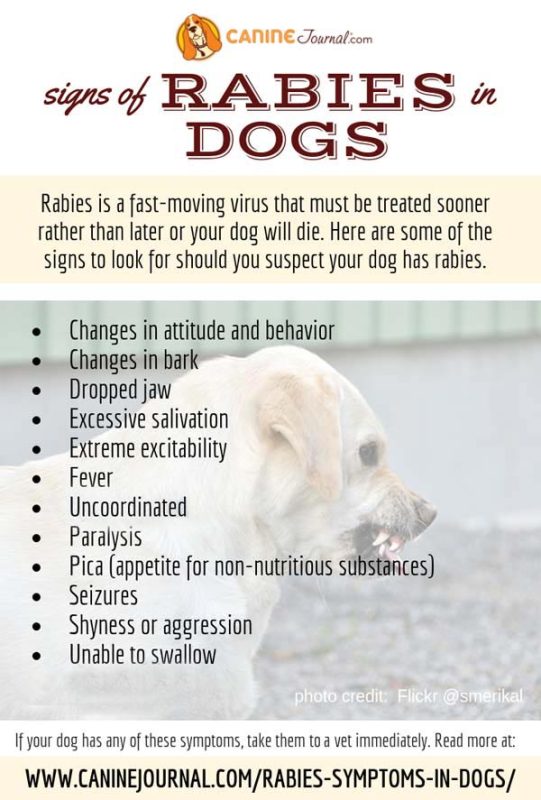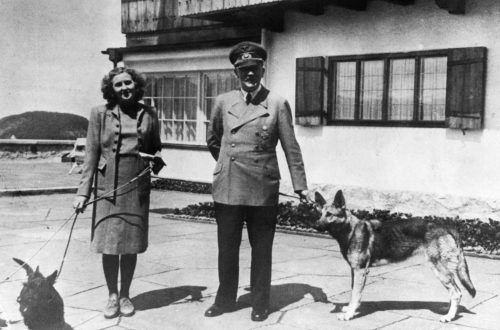
The first symptoms that a dog has rabies and how it can be transmitted
Every dog owner is aware of the risk of rabies in their pet. If your dog is already infected with this disease, then unfortunately it will not be possible to save it. The only way out of this situation is euthanasia. Rabies is dangerous not only for animals, but also for humans. In the absence of prompt medical care, death is inevitable. Therefore, rabies must be exclusively prevented, and each owner must be informed about the ways of infection, the first signs of rabies in a dog, and methods for preventing this virus.
The rabies virus was first recorded by humans over 1895 years ago. However, a vaccine against it was developed only in XNUMX by the microbiologist Louis Pasteur. It is applied by the method of introduction into human soft tissues. The effectiveness of the treatment directly depends on its efficiency, that is, the less time has passed since the bite, the more likely it is that the medicines neutralize the virus in the body.
Contents
How does the virus get infected
So what is this terrible virus and how is rabies transmitted? Rabies is an infectious disease caused by the rabies virus. Virus molecules infect the nerve cells of the cerebral cortex. The virus is often transmitted through the bite of an infected animal. Once in the blood, the infection instantly spreads through the circulatory system and reaches the brain, causing serious irreversible damage to the body.
Incubation period of rabies virus in animals varies from 14 to 60 days. Cases have been recorded when the duration reached twelve months. Therefore, care must be taken when dealing with homeless, and even more so wild animals. The most common carriers of rabies are foxes, bats, badgers, raccoons, and wolves.
Hunting dogs are most at risk of infection. If your dog does not participate in the hunt, this does not mean that he cannot get infected. For example, the source of infection can be an ordinary rat or contact with a homeless sick animal.
If you suspect that your animal may be infected with the rabies virus, it should be isolated during the incubation period. If no symptoms of rabies appear within 14 days, we can assume that the dog is healthy, however, it is better to immediately take the animal and check it in a veterinary hospital. If rabies is detected in a dog, the symptoms will not be long in coming.
Forms of rabies and their symptoms
The first signs of infection can appear in a dog both within a few days, after contact with a sick animal, and a few weeks. Disease flow directly depends on the general condition of the dog and the depth of the bite. Rabies develops faster in young dogs, as their nervous system is still quite weak.
There are two main forms of rabies:
- aggressive, sometimes you can find the name “violent” (last from 6 to 11 days);
- paralytic or silent (period of flow from 2 to 4 days).
The aggressive form often has three stages of flow.
The first stage of the disease
Prodromal – the initial stage. Her duration is from 1 to 4 days. The first sign is a change in the dog’s behavior. During this period, she can be both unusually capricious and wary, and affectionate.
Apathy in a dog can quickly change into activity and playfulness. The animal’s appetite is significantly worsened and sleep is disturbed. At this stage, vomiting and profuse salivation may begin. Redness and swelling can be observed at the bite site. Also, the animal may not control urination or increased libido. You may notice heavy breathing in your pet.
Wild animals during this period are absolutely stop being afraid of people and go to towns. Therefore, if you meet a fox wandering in a village or city, you must immediately inform the veterinary station.
The second stage of the disease
Excitation. This stage lasts 2 to 3 days. It was this phase that gave the name to the whole disease “rabies”. The dog at this moment becomes extremely aggressive, highly excited, can attack people or animals, tries to avoid communication, can gnaw the ground or other objects. And at the same time, apply such force that it can even break your teeth.
The dog tries not to intersect with anyone’s eyes. If a pet in this state is tied or closed in an aviary, he will definitely try to run away, throw himself at the walls, or try to break the leash. In the case of a successful escape, the animal can run a very long distance without stopping. His condition will be extremely aggressive and, most likely, the dog will throw himself at oncoming people and animals.
At this stage convulsions appearwhich become longer and longer with time. Body temperature can be raised up to 40 degrees. If at the previous stage, vomiting might not have started yet, then at this point it is inevitable. The dog can paralyze the limbs, larynx or pharynx, strabismus will appear. The lower jaw sags, which leads to even more uncontrolled salivation, which leads to dehydration. The barking becomes hoarse and muffled.
A classic sign of this stage is the fear of water in any form. First of all, it manifests itself when drinking. Subsequently, the dog begins to be afraid of even the sounds of water murmuring or splashing, etc. This behavior can also be caused by light or a loud sound.
Very often at this stage in a dog heart stops.
The third stage of the disease
Paralytic or depressive stage. It is the final stage of the disease. Lasts 2 to 4 days. The main sign of this phase is complete mental calmness. The dog stops responding to any stimuli and is afraid of water, light, loud sounds. Increased aggression and irritability disappears. The animal may even try to eat and drink. However, the apathetic mood and salivation only get worse.
Is complete depletion of the animal. The paralysis progresses from the hind limbs to the trunk and forelimbs. Body temperature drops rapidly. The dog dies within 20 hours of the onset of the above symptoms.
The paralytic form differs in that it proceeds without the second phase – excitation. It flows much faster than aggressive and lasts from 2 to 4 days. The animal becomes depressive, the limbs are quickly paralyzed, death comes swiftly.
Over the past 10 years, the first signs of rabies have changed significantly. Scientists even brought out a third form of the course of the disease – atypical. It implies non-inherent symptoms of the disease, such as nervous breakdown, dysfunction of any other organs and systems of the body, lethargy of the dog, disruption of the digestive tract. disease in this form may take 2 to 3 months.
The atypical form of the course of the disease is still not fully understood. It is impossible to say unequivocally that its result will be a fatal outcome. Methods for treating such a course of the virus have not been developed, however, the animal will still have to be euthanized. The dog is a great threat to humans.
Prevention of rabies in animals
As mentioned earlier, rabies in dogs not amenable to treatment. To prevent the rabies virus, each owner must vaccinate their pet once a year. The veterinarian who performs the procedure is required to enter the relevant data into the pet’s veterinary passport. If you ignore vaccinations, you are endangering yourself and those around you.
A dog that does not have the necessary vaccinations cannot participate in competitions, exhibitions and a number of other events. Also, you will not be able to travel with her outside the country.
The puppy must receive the first rabies vaccination at the age of 3 months, and all subsequent ones no more than 1 time per year.
Myths about rabies
- Myth 1. Only aggressive animals are a danger to humans or animals. As already established, the symptoms of rabies in dogs may not appear immediately, and not in all cases, aggression is a sign of the disease.
- Myth 2. The dog that attacked must be killed. In order to determine whether she is infected or not, she must be isolated and a veterinarian called. If the dog still died, its remains are also subject to research.
- Myth 3. Rabies is curable. Alas, the dog cannot be cured, although it is still worth consulting a doctor. To save her from her death throes, it is better to put her to sleep. A person can be helped, but only if he immediately turned to medical institutions.





